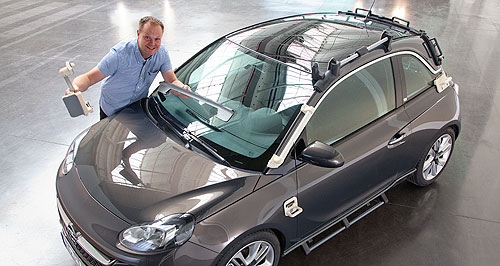News - OpelOpel builds Adam using 3D-printed toolsFantastic plastic: Opel’s virtual simulation engineer Sascha Holl with the new Adam Rocks – a light crossover car assembled using 40 tools made on a 3D printer. Cost savings push Opel to print tools rather than make them the old way25 Aug 2014 OPEL says it has saved up to 90 percent of the cost of making tools to help it build the Adam and upcoming Adam Rocks city hatchbacks by forming them on a 3D printer. The 40 different tools used in the assembly process are made by Opel’s virtual engineering team at the company’s headquarters in Russelsheim, who are pioneering the technology for General Motors. The new Adam Rocks light crossover car is assembled using 40 3D-printed tools, which include a jig to produce the ‘Adam’ badging on the rear passenger window a guide inlet to help mount and precisely align the windscreen a piece of equipment used to fasten the step plates on the door sills and another to attach the canvas roof. Virtual simulation engineer Sascha Holl said a huge advantage to 3D printing Opel’s own tools was being able to tailor-make them for a specific purpose. “It enables us to quickly adapt the parts,” Mr Holl said. “If something changes on the vehicle, we can easily modify the tool with just a few clicks. “The 3D printing process enables us to produce every imaginable form and shape. Unlike conventional manufacturing technology, we don’t have to accept any limitations.” Opel’s 3D printing process layers melted plastic in 0.25 mm thick sections. The plastic used is lightweight, tough and versatile. Before 3D printing, jigs used in the final assembly stages of a car were made by hand in a drawn-out process that involved using a milled cast and resin. Printed tools are ready to use in about eight hours, they’re 70 percent lighter and up to 90 percent cheaper to produce. The plastic tools can also be sanded, drilled and milled to make them more ergonomic for the user. “We can adapt the tools for each assembly situation, as well as make them user-friendly for our colleagues on the line,” Mr Holl said. The Adam and Adam Rocks are not the only Opel-badged vehicles to be built using the printed tools, which is expected to grow across the car-making industry. The Opel Insignia mid-size sedan and wagon, and Cascada convertible, are also assembled using the printer-formed tools, with the new Corsa due on sale in Europe late this year expected to be among other models to benefit from the technology. Opel pulled out of the Australian market in 2013 due to slow sales, but some of the European-engineered models from GM’s German wing are already confirmed to return next year wearing Holden badges, including the Cascada convertible. Other Holden-badged Opels will include the performance-honed Astra VXR and Insignia VXR.  Read more |
Click to shareOpel articlesMotor industry news |
















Facebook Twitter Instagram